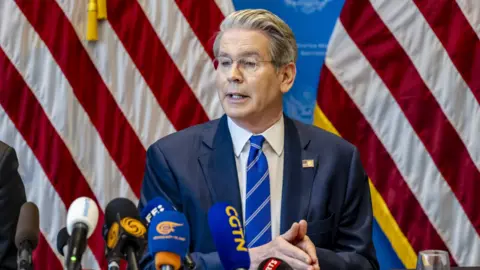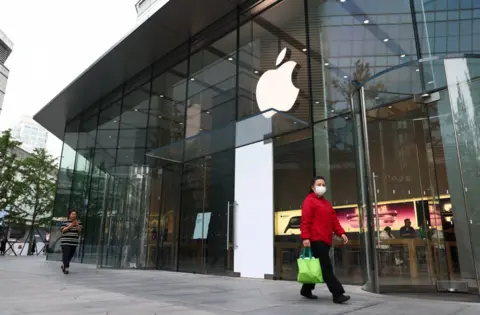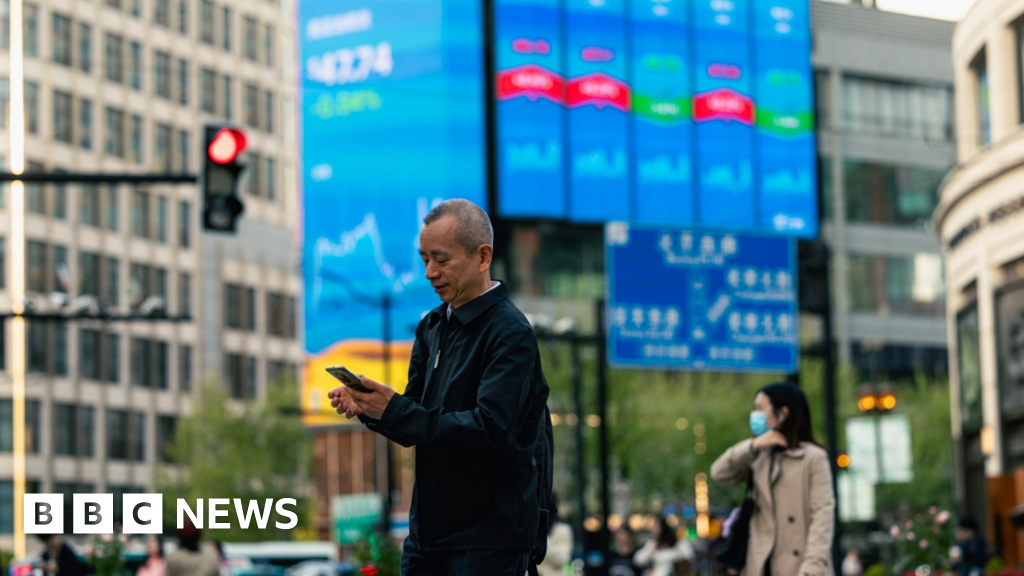 EPA
EPAChina’s defiance as it faced down US President Donald Trump’s tariffs has been a defining image of this trade war.
It has prompted viral memes of Trump waiting for the Chinese leader to call.
“We will not back down,” has been an almost daily message from Beijing’s Ministry of Foreign Affairs. As the tariffs and the rhetoric from Washington escalated, China dug its heels in.
Even as Chinese officials headed to Switzerland for talks, a state-run social media account published a cartoon of the US Treasury secretary pushing an empty shopping trolley.
There were even conflicting versions of who initiated the talks in Geneva.
But after two days of “robust” talks, the situation appears to have changed.
So, is this a major turning point for Washington and Beijing? The answer is yes and no.
‘We want to trade’
“The consensus from both delegations this weekend is neither side wants a decoupling,” said US Treasury Secretary Scott Bessent during a press conference in Geneva.
“And what had occurred with these very high tariffs… was the equivalent of an embargo, and neither side wants that. We do want trade.”
 EPA
EPAEconomists admit that this agreement is better than expected.
“I thought tariffs would be cut to somewhere around 50%,” Zhiwei Zhang, chief economist at Pinpoint Asset Management in Hong Kong, told Reuters news agency.
But in fact, US tariffs on Chinese imports will now fall to 30%, while Chinese tariffs on US goods will drop to 10%.
“Obviously, this is very positive news for economies in both countries and for the global economy, and makes investors much less concerned about the damage to global supply chains in the short term,” he added.
Trump hailed the progress on Sunday on his Truth Social site: “Many things discussed, much agreed to. A total reset negotiated in a friendly, but constructive, manner.”
Beijing has also softened its tone considerably– and perhaps for good reason.
China can take the pain of an economic war with America – to an extent. It is the lead trade partner for more than 100 other countries.
But officials have become increasingly concerned about the impact the tariffs could have on an economy that is already struggling to deal with a property crisis, stubbornly high youth unemployment and low consumer confidence.
Factory output has slowed and there are reports that some companies are having to lay off workers as production lines of US-bound goods grind to a halt, bringing trade to a standstill.
Data on Saturday showed China’s consumer price index dropped 0.1 percent in April, the third month in a row of decline as consumers hold back from spending and businesses drop prices to compete for customers.
 EPA
EPAThe Chinese Commerce Ministry said on Monday that the agreement reached with the US was an important step to “resolve differences” and “lay the foundation to bridge differences and deepen cooperation”.
Such a positive statement from Beijing would have seemed inconceivable just a month ago.
The two sides have also agreed to more talks, or an “economic and trade consultation mechanism”, as Beijing puts it.
But Trump’s characterisation of a “total reset” in relations may be overly optimistic as there is a slight sting in the tail in Beijing’s statement.
The Commerce Ministry ended with a reminder of who it sees as being in the wrong.
“We hope that the US will continue to work with China to meet each other halfway based on this meeting, thoroughly correct the wrong practice of unilateral tariff increases,” said the spokesperson.
Chinese state media also had a warning for Washington. Xinhua News Agency’s commentary claimed China’s “goodwill and patience has its limits, and it will never be used on those who repress and blackmail us without pause or have no qualms about going back on their word”.
Leaders in Beijing will want to portray an image of strength both to its own people and to the international community. They will want to appear as if they have not budged an inch. The message from China is that it is being responsible and rational and doing what it can to avoid a global recession.
“This is a victory for conscience and rationality,” said Zhang Yun from the School of International Relations at Nanjing University.
“The talks also established the necessary framework for continued dialogue and negotiations in the future.”
This “victory” is only for 90 days. The tariffs are only paused temporarily to allow for negotiations.
It will allow some trade to flow, and it will soothe worried markets.
But the root of the problem still exists. China still sells far more to the United States than it buys. And there are other, far thornier differences to unpick, from Chinese government subsidies, to key industries, to geopolitical tensions in the Taiwan Strait and beyond.
The fight for a more balanced trade relationship is far from over – it has simply moved.
The frontline has shifted from China’s factory floors and American supermarkets to negotiating tables in both Beijing and Washington.

